Hurling is hard to describe.
“It’s kinda like lacrosse and it’s kinda like murder,” said Todd Brothers, founder of Portland’s national championship Irish hurling team, Columbia Red Branch.
Their breakthrough came last year when Red Branch won the national tournament for their division in San Francisco.
Hurling is thousands of years old and an Irish pastime. But here, hurling remains a vicious-looking question mark to those who don’t play it.
At full speed, hurling looks like it has no rules. It’s just a flurry of running, kicking and thrashing of sticks in frighteningly close proximity to vital body parts.
It’s nearly impossible to look away from.
“One of the cool things about it is it looks incredibly dangerous and violent without actually being very dangerous or violent,” Brothers said.
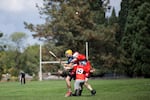
Players clash during a 2017 pub league hurling match in Portland.
Bradley W. Parks / OPB
Brothers is a puckish history teacher in La Center, Washington. A shock of dark hair sprouts from the center of his head. His hands are like a coral reef, formerly broken fingers rigidly pointed in different directions in a variety of colors.
Brothers and his friends started playing this medieval game almost 20 years ago. They built their own equipment, were regularly injured — and had to recruit people to join them.
“We cycled through players like crazy, especially at the beginning when we were a lot rougher,” Brothers said.
When Red Branch play in local parks, people stop — sometimes for minutes on end, which is remarkable in the age of digital feed bags attached to our hands.
But people watch, temporarily transfixed by these people swinging what look like axes, chasing a tiny ball.
What Is Hurling?
Northwest hurlers tend to describe their sport by what it isn't. It's not competitive vomiting. It's not played with big rocks and brooms on a sheet of ice. It's not caber-tossing. It's not lacrosse or field hockey.1
Hurling is one of four Gaelic games, along with camogie (women’s hurling), Gaelic football and handball.
It’s played on a pitch a little bigger than a soccer field with goals at each end. Each team has 15 players on at once.
There’s a ball called a “sliotar” about as big as a baseball.
Players carry sticks called “hurleys” or “hurls.” They have long, slender handles with a flattened “boss” about as big as a pie plate curving up at the end.
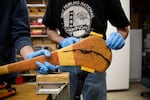
Fixing a broken hurley in Curt Yackell's garage in Vancouver.
Bradley W. Parks / OPB
The goal looks like a giant H — a soccer goal on the bottom with American football uprights sticking up from the sides.
Teams score by hitting the ball into the net (worth three points) or between the uprights over the bar (worth one point).
The rules are complicated and, frankly, unnecessary for a basic understanding of the game. But here are just a few:
- Players can't pick the ball up off the ground with their hands. They have to use the stick.
- Players can catch the ball in the air or off a bounce. (Getting murky already, right?)
- Players can kick and hand-pass the ball. They cannot throw it.
- Players can carry the ball in-hand for only four steps but can balance or bounce it on the stick for unlimited time.
Hurling was, in its early days, a gruesome sport built on a rivalry between towns and counties in Ireland.
Teams played by their own rules. Matches were either violent, sloppy, lazy, boring or all of the above.2
In the 1980s, after the Gaelic Athletic Association allowed helmets in hurling, one journalist for the Galway City Tribune waxed nostalgic about the way the game used to be, "when men were tougher, and were not in the least perturbed by the sight of blood 'pumping' from a gaping head wound. But times have changed."3
To survive in Ireland — and certainly in the U.S. — hurling couldn't be the savage game it once was.
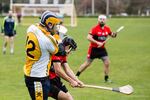
Duck! David Dodson smacks a ball out from goal during the 2018 season-opening hurling tournament in Tacoma.
Bradley W. Parks / OPB
Discovery In Pennsylvania
Even given Portland’s penchant for “weird” things, hurling’s growth here is surprising.
Brothers, the Red Branch founder, first learned of hurling when writing his master's thesis on medieval Ireland in 1990. He came across mentions of it in Irish law, like this one in which the town of Kilkenny tried to ban it:
“... it is ordained, and established, that the commons of the said land of Ireland, who are in the different marches at war, do not, henceforth, use the plays which men call horlings, with great sticks and a ball upon the ground, from which great evils and maims have arisen …”
“So I decided I want to play that game,” Brothers said.
In 2001, he went to the Pennsic War, an enormous medieval reenactment-slash-campout in Pennsylvania. There he found a class on ancient Irish hurling.
“I came running back to camp with my stick in my hand like, ‘We’re gonna do this! We’re gonna do this!’” he recalled.

Todd Brothers in his middle school classroom in La Center, Washington. In addition to hurling, Brothers participates in medieval reenactment and armored combat — swordfighting, to the layperson.
Bradley W. Parks / OPB
When he came home, Brothers tore open a baseball and started calling friends. One of them was Curt Yackell, now Red Branch’s president.
Brothers explained the game as “kinda like if you took soccer and baseball and lacrosse and hockey … pushed it into one game and played it on grass.”
“I was like, ‘You know, I kinda want to play this game,’” said Yackell, who is average height with skinny legs and a gentle voice.
He and Brothers both fenced when they were younger, which requires incredible precision and skill.
“Just trying to perfect a skill ... that’s the driving force for me,” Yackell said. “With hurling, there’s thousands of skills.”
Everything about hurling was unknown to them when they started playing. Brothers said it was like an experiment in "living archaeology."4
They made a sliotar. Brothers bought planks of oak and ash from the hardware store to shape their own hurleys.
Theirs were blunt and club-like. They built them from Brothers’ memory of what a hurley looked like.
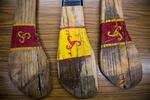
Three of the original Red Branch hurleys.
Bradley W. Parks / OPB
A proper hurley is made from the root of an ash tree, so the wood grain follows the curvature of the stick. They break less. The straight grain on those hardware store hurleys and the rowdy nature of their early games led to a lot of broken sticks — and a few injuries.
“It was a little scary … some people only played once,” Brothers said.
After a few months, however, they could count on six or seven people in the Portland-Vancouver area to play hurling consistently. A friend from Seattle recruited people to play up north.
Brothers helped stage hurling “matches” (in period attire) at medieval festivals and reenactment events around the region.
Their odd game started attracting attention. Portland and Seattle teams took shape.

From left in red, Curt Yackell, Frank Mazna and Todd Brothers in one of Red Branch's earliest games against Seattle.
Courtesy of Curt Yackell
Brothers became certified as a coach, others as referees. They named the Portland team Columbia Red Branch. And in 2005, they registered with the GAA.
They were laying the foundation for a Northwest hurling league.
The Tenuous Task Of Survival
In April, Portland’s two Irish hurling clubs had traveled more than two hours to fields south of Tacoma for the 2018 season-opening tournament.
Each team was promised three games. With refs.
But 15 minutes past their scheduled start time, Red Branch and Willamette Hurling Club had no ref and no opponents aside from each other.
So the two Portland clubs squished through warmups on a sun-soaked but also recently rain-soaked and soon-to-be-rain-soaked-again pitch. One player volunteered to ref, grabbed a jacket, looked for a whistle that wasn’t there and eventually gave up.
“I’ll just yell ‘STOP’ really loud,” he said.
Hurlers wear helmets. Some wear shin guards and padded gloves, but, unlike lacrosse, they are otherwise unprotected.
Sticks slam together in thunderous claps that send up fireworks of rainwater in wet weather.
“It’s a very physical and aggressive sport, but it’s also really elegant,” Brothers said. “If you watch really good hurling, it’s incredible to watch. It’s like ballet.”
Players spin and shoulder. They can balance the ball on a hurley like an egg on a spoon at a dead sprint.
Hurling is brutal and beautiful.
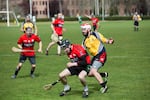
Enda Grogan, center, spins in attempt to get by Scott Meyers, right, a Red Branch player dressed for the opposing side.
Bradley W. Parks / OPB
Players here struggle to imagine their lives without it. But some teams have walked on the edge of extinction while some have fallen over it completely.5
Because, to continue in the U.S., not only must people commit to playing hurling; they must commit to learning it too.
"You are trying to recruit adults who have busy lives," said Steph Hartford, who plays for Willamette.6
The Willamette club nearly folded three years after its founding. Since, Hartford said, they’ve worked to build a core group of players to allay fears of shutting down.
“[Fear is] always there,” Hartford said. “And so I think you have to enjoy the time and the experiences that you do have, but not cling to it so tightly that your life is gonna be over if it ends.”
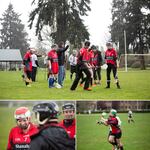
Clockwise, from top: Curt Yackell gives instructions as the Red Branch camogie team heads out for their first-ever match; Paula Konomos clears a ball downfield; Kristin Pollock smiles as rain drenches the team.
Bradley W. Parks / OPB
The Northwest Hurling League has teams in Corvallis, Tacoma, Seattle, two in Portland and two in Montana. Some clubs like Red Branch have added Gaelic football and camogie teams too.7
But for Gaelic games in this part of the world, sometimes there still aren't enough players. And sometimes there are no refs.8
‘What It Means To Me’
Curt Yackell keeps three of the hardware store hurleys hanging in his garage. He’s repeatedly pieced the oft-shattered remains back together.
He’s rebuilt himself too. A recent knee surgery almost ended his playing days.
Yackell’s comeback from that injury reminded him that hurling makes him whole.
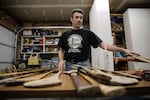
Yackell has a hurley graveyard in his garage. Looking through the broken sticks is a bit like looking through a photo album for him.
Bradley W. Parks / OPB
In one of his first games after surgery, he launched a ball down the pitch to a sprinting teammate who caught it and smacked a point over the bar.
It was his son Evan, who’s played with him on Red Branch for several years. For them, hitting the sliotar around was like playing catch while Evan was growing up.
“Those are the things that make you — I don’t know ...” Yackell trailed off, wiping tears away from his cheeks. “That’s what it means to me. The club and the game and all of it.”
Yackell apologized for crying as he sat amongst his best memories of the sport he’d given so much of his life to.
“Ugh, jeez,” he said. “I can’t believe you made me do that.”
But that’s what sports do: They push us to the edges of human emotion we don’t visit often and don’t expect to visit at all. Places where we scream louder, laugh harder and cry deeper.
Even if you play a sport that nobody knows.
1 It's important to note here that hurling is only virtually unknown in the U.S. Many Americans (including many Irish immigrants) play hurling here, clearly, but most Americans, safe to say, don't know what it is. This YouTube sizzle reel, complete with iMovie graphics and jock jams, ought to give you the gist. (And if this doesn't excite you about hurling, literally nothing will.) return
2 “[T]here were at times during the contest a half-dozen of the hurlers lying with their faces on the ground resting themselves,” wrote Michael Cusack — who founded the GAA — of an 1887 match. return
3 The GAA did not require helmets for all levels of hurling until 2010. "There are significant injuries which can be sustained in these areas including scalp lacerations, concussions, skull fractures, jaw fractures, cheek bone fractures, nasal fractures, penetrating eye injury and orbital fractures, facial lacerations and damage to and avulsion of teeth in both the upper and lower jaws," their statement read. How sensitive of them. return
4 For comparison, check out this documentary of Ireland's first national baseball team. Around the 2:30 mark you'll see some of the team's earliest batting practice and it is glorious, especially the seemingly random slow-zoom to a guy in acid-wash jeans lounging in the field. return
5 Scott Meyers, who plays for Red Branch, started a club called the Eugene Trappers while at school at the University of Oregon. The team didn't last long past his graduation. Some of its members joined Red Branch, others formed Willamette and some joined the Benton Brigade in Corvallis. return
6 Brothers said on Red Branch's first trip to nationals in 2011, their team's average age was 35 — with a 14-year-old outlier. return
7 Red Branch in 2017 won the Junior C hurling national championship. Hurling in the U.S. is divided into "Junior" and "Senior" divisions and classes A, B and C (Junior C being the lowest level, Senior A the highest). Competition is stiff and there are limits to the number of Irish players allowed on the field at any given time as teams level up. Red Branch will now play in Junior B, but it took 17 years to get there, showing just how difficult leveling up can be. return
8 Most teams in the Northwest have enough players to field a full 15 at a match. Red Branch and the Seattle Gaels especially maintain strong roster sizes. But making 15 — with subs — can be a challenge for others. For example, at that season-opener in Tacoma, Red Branch players took turns suiting up for Willamette and the Tacoma Rangers to fill sides. That reliance on and friendliness with other cities have helped hurling grow in the Northwest. return


